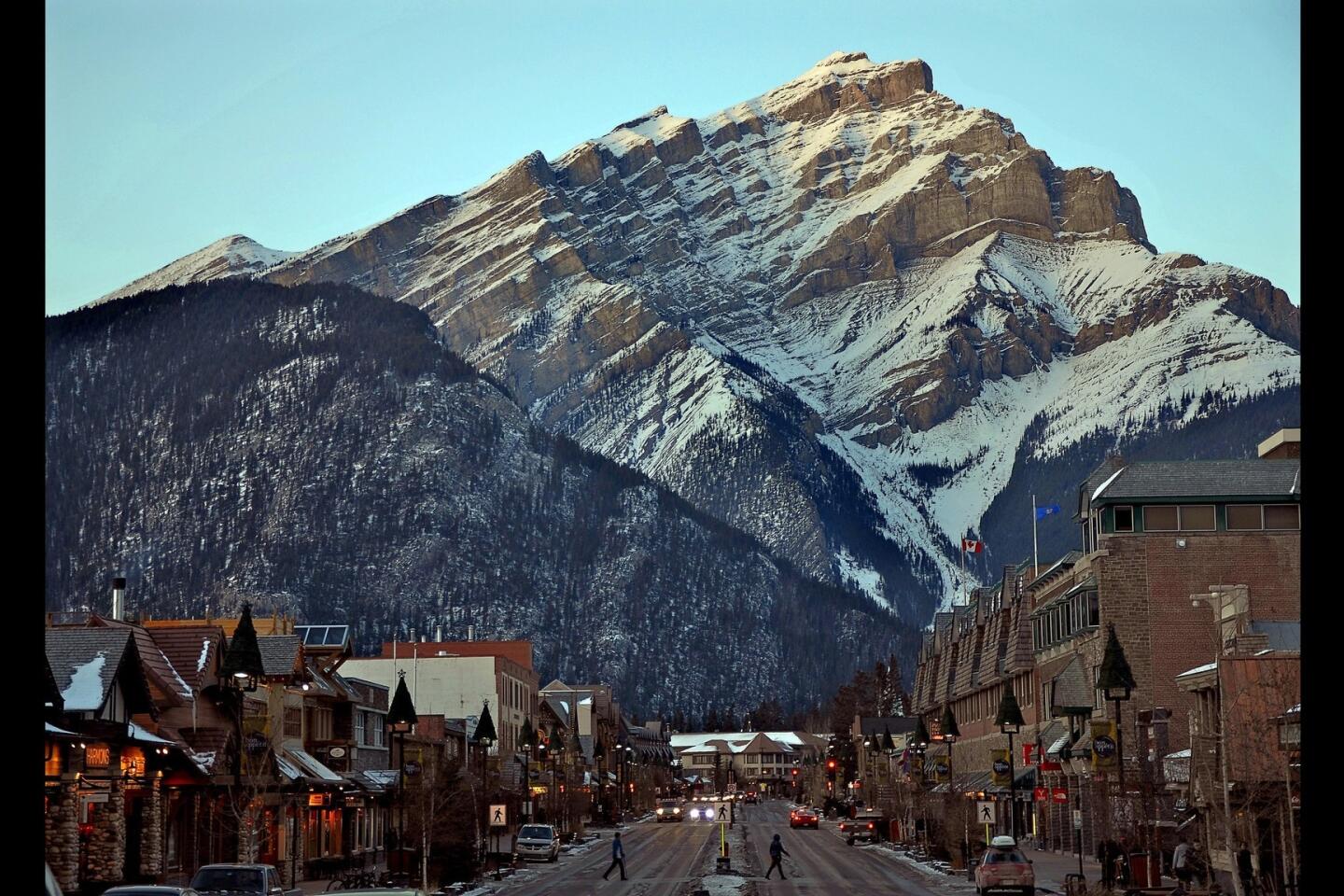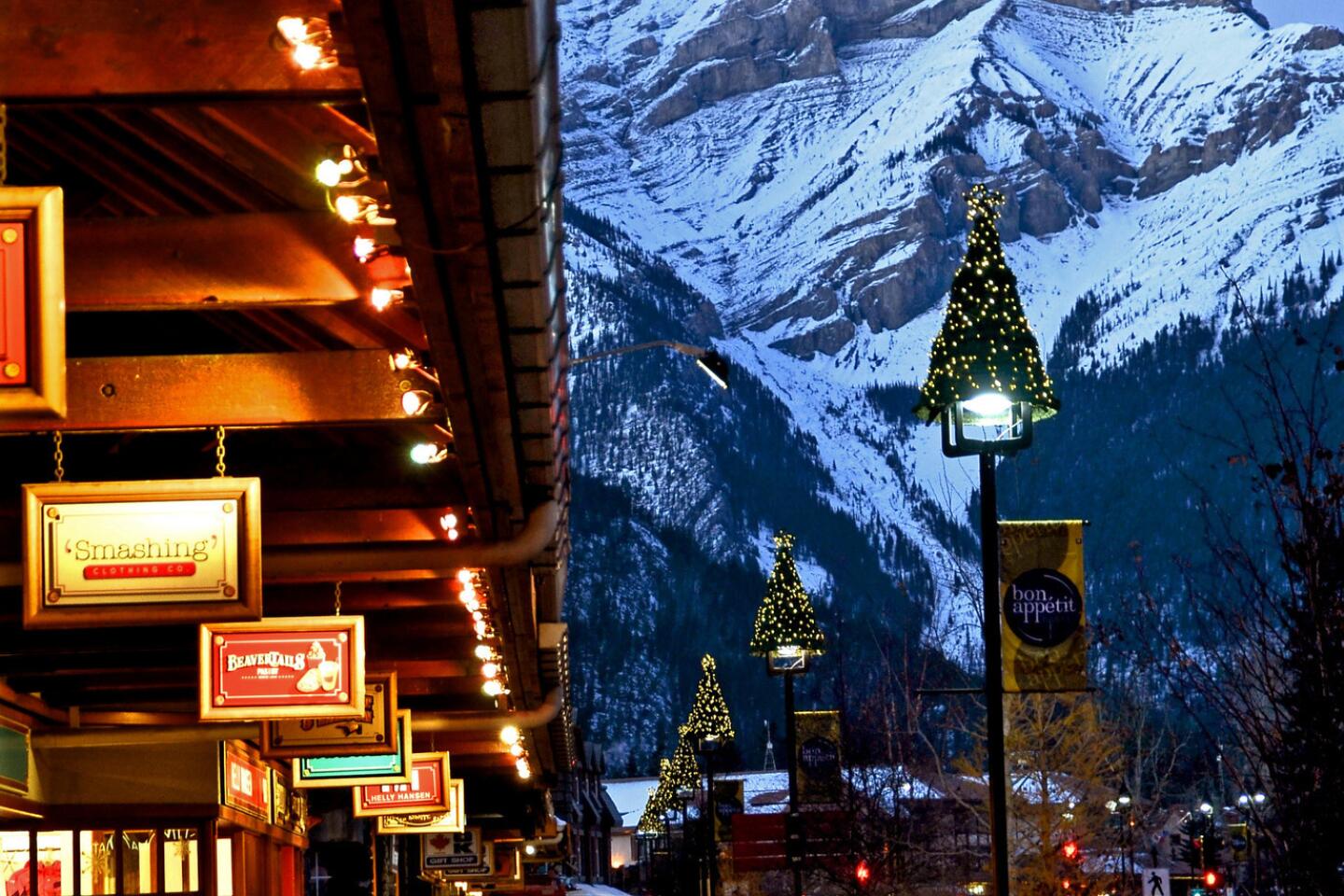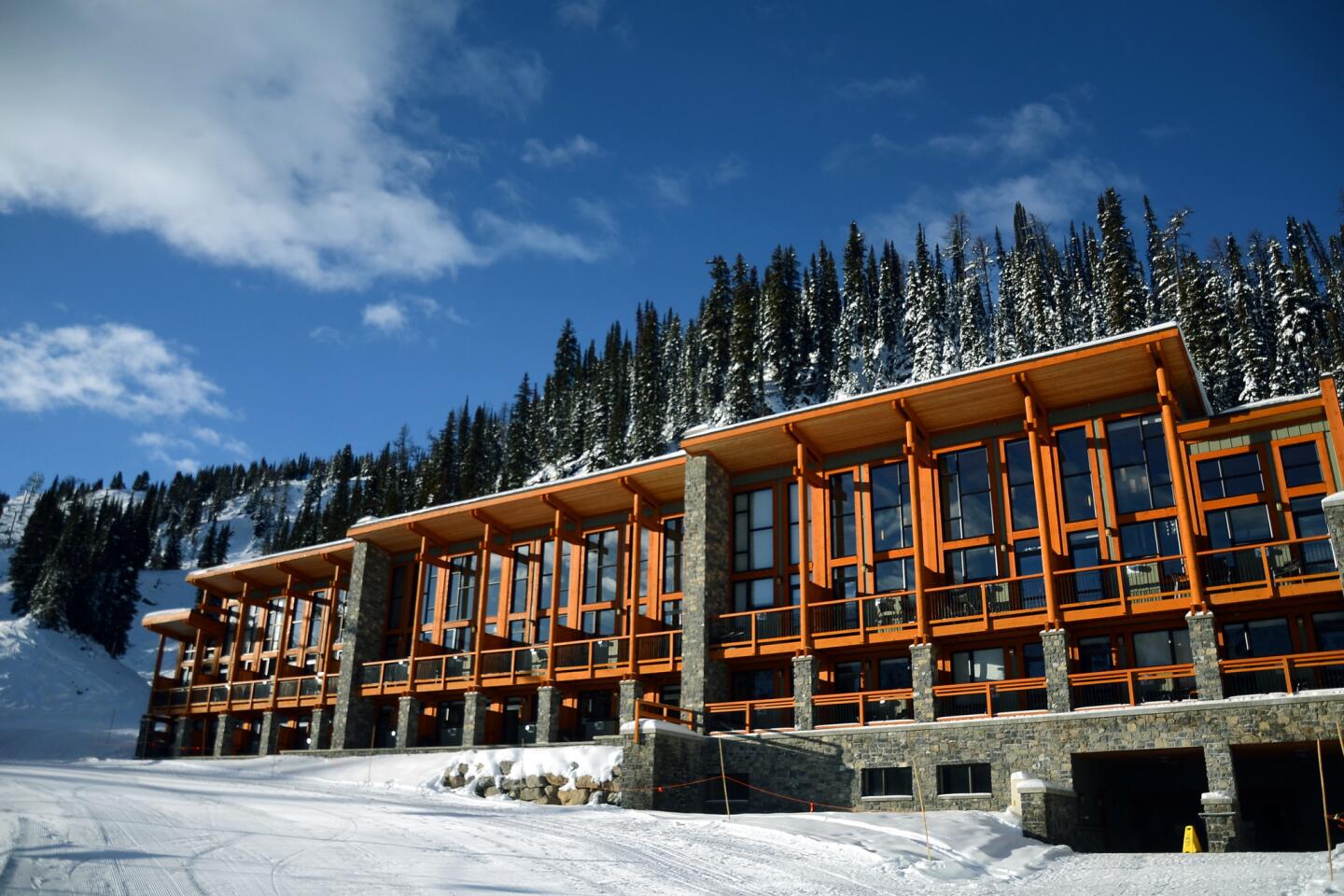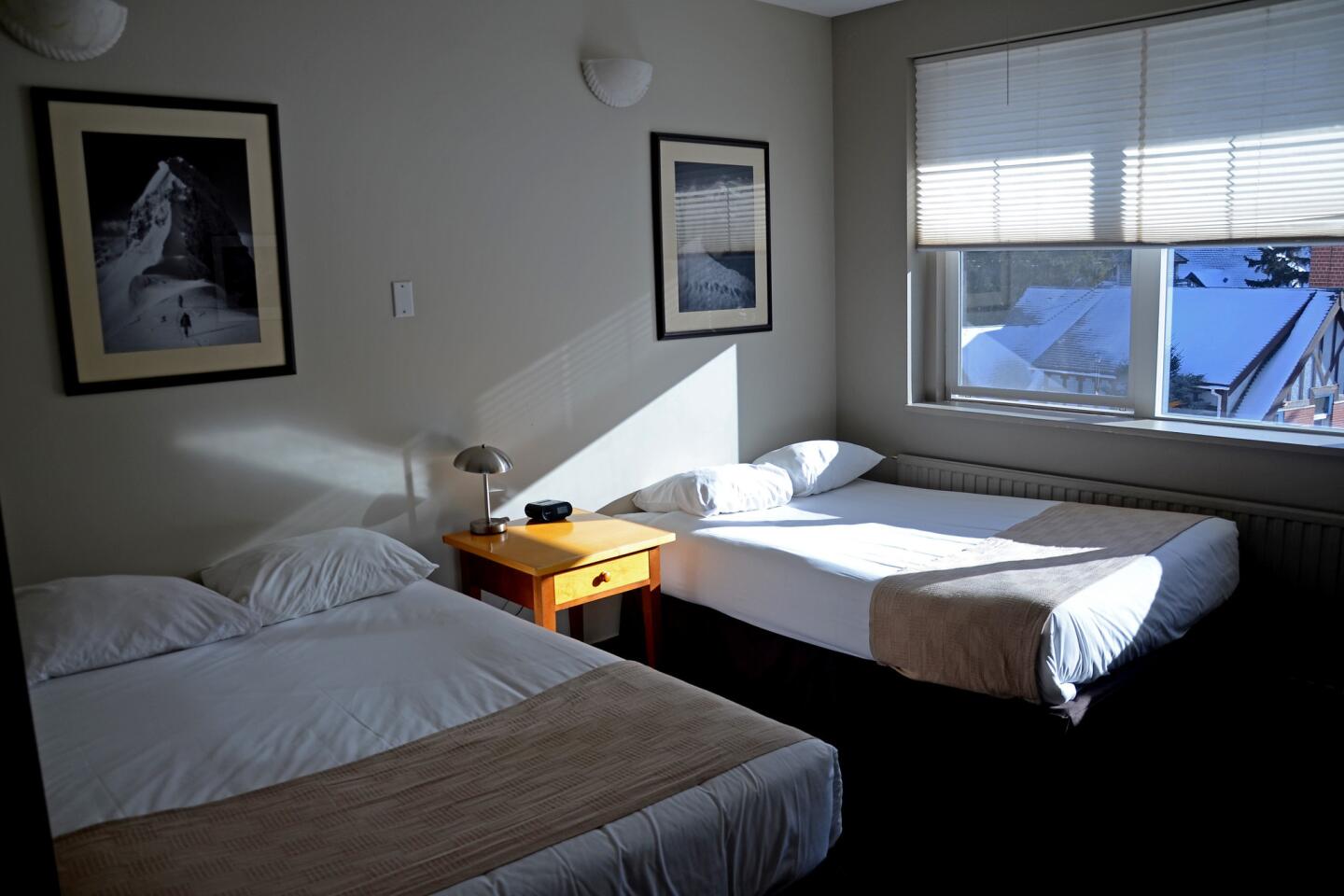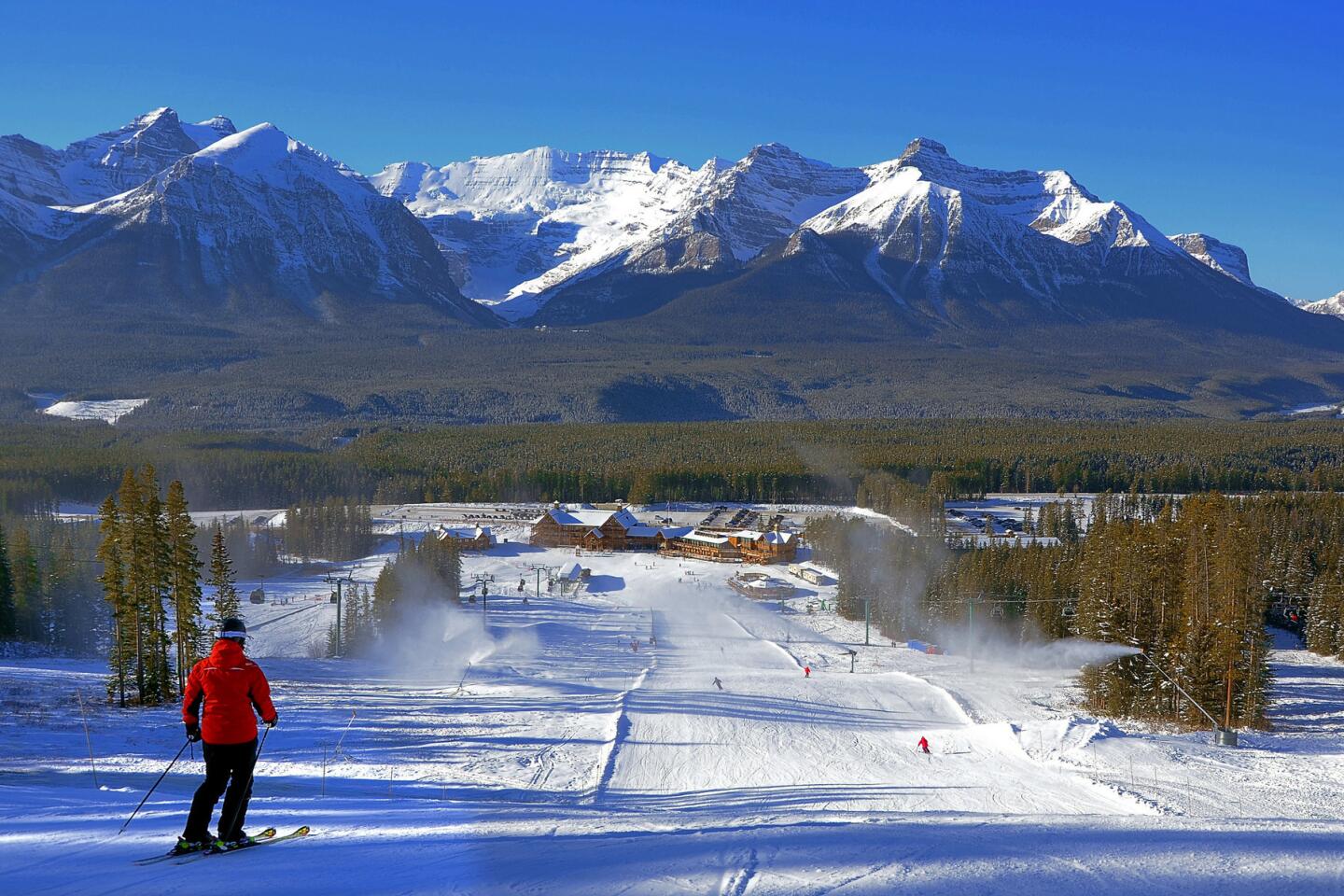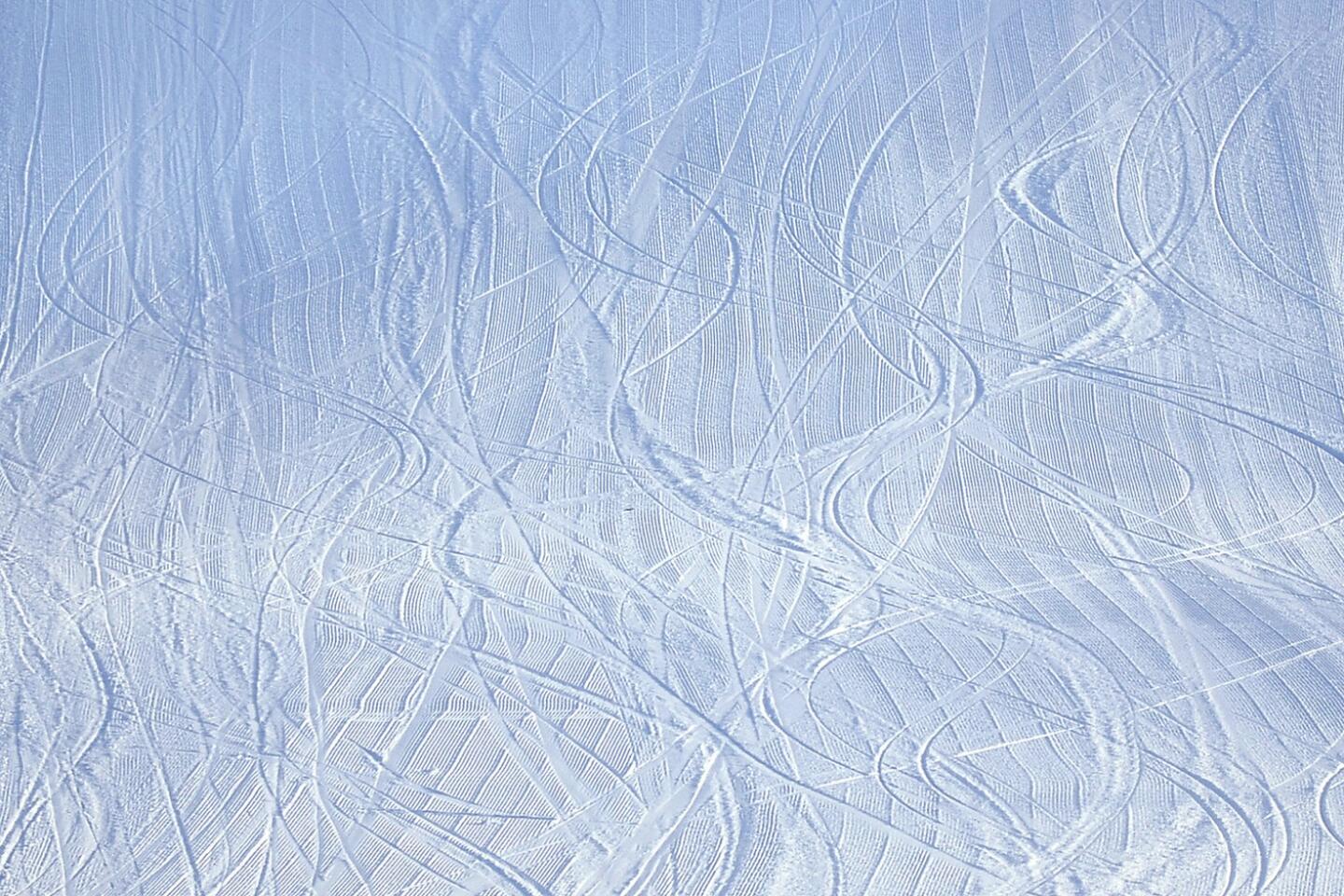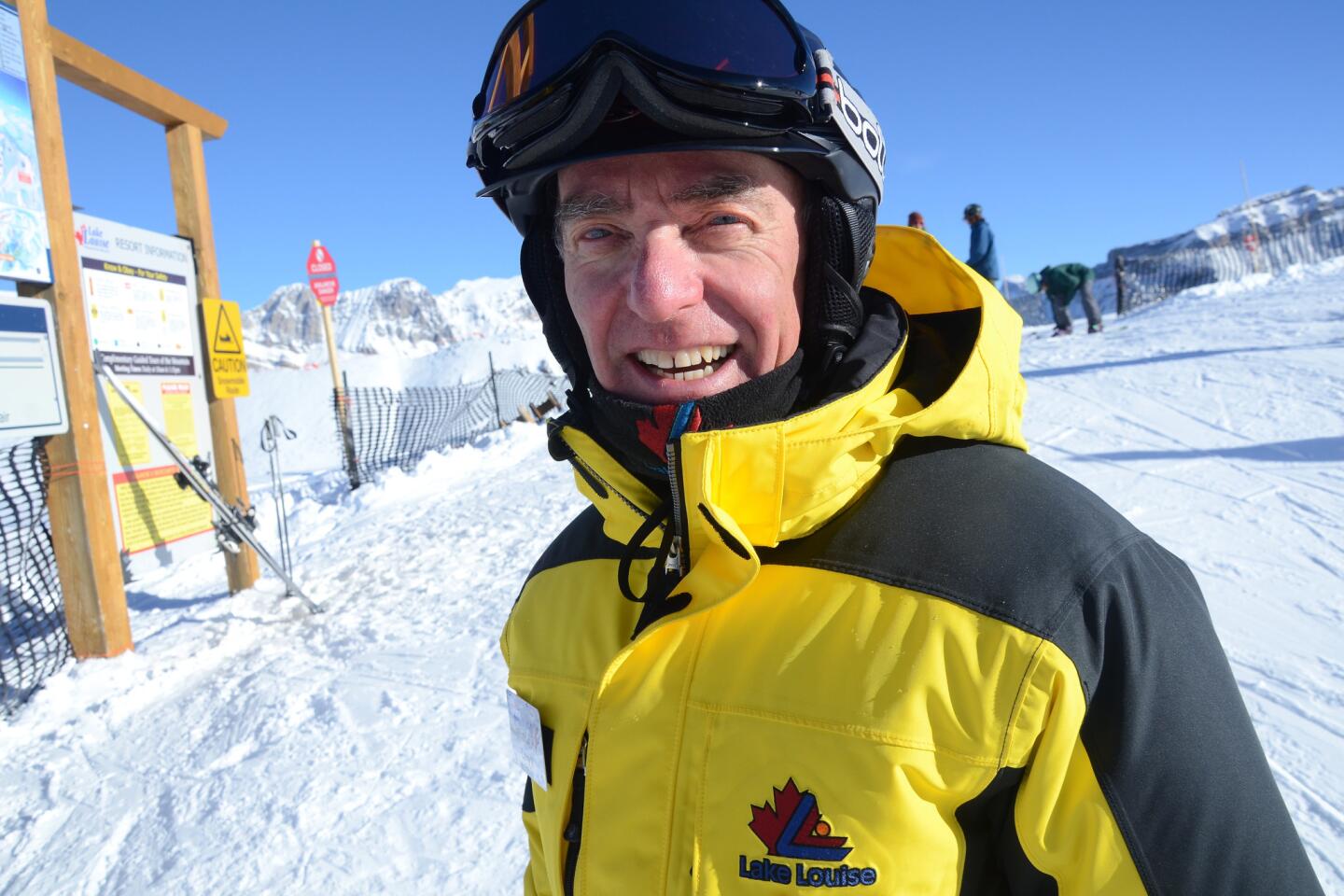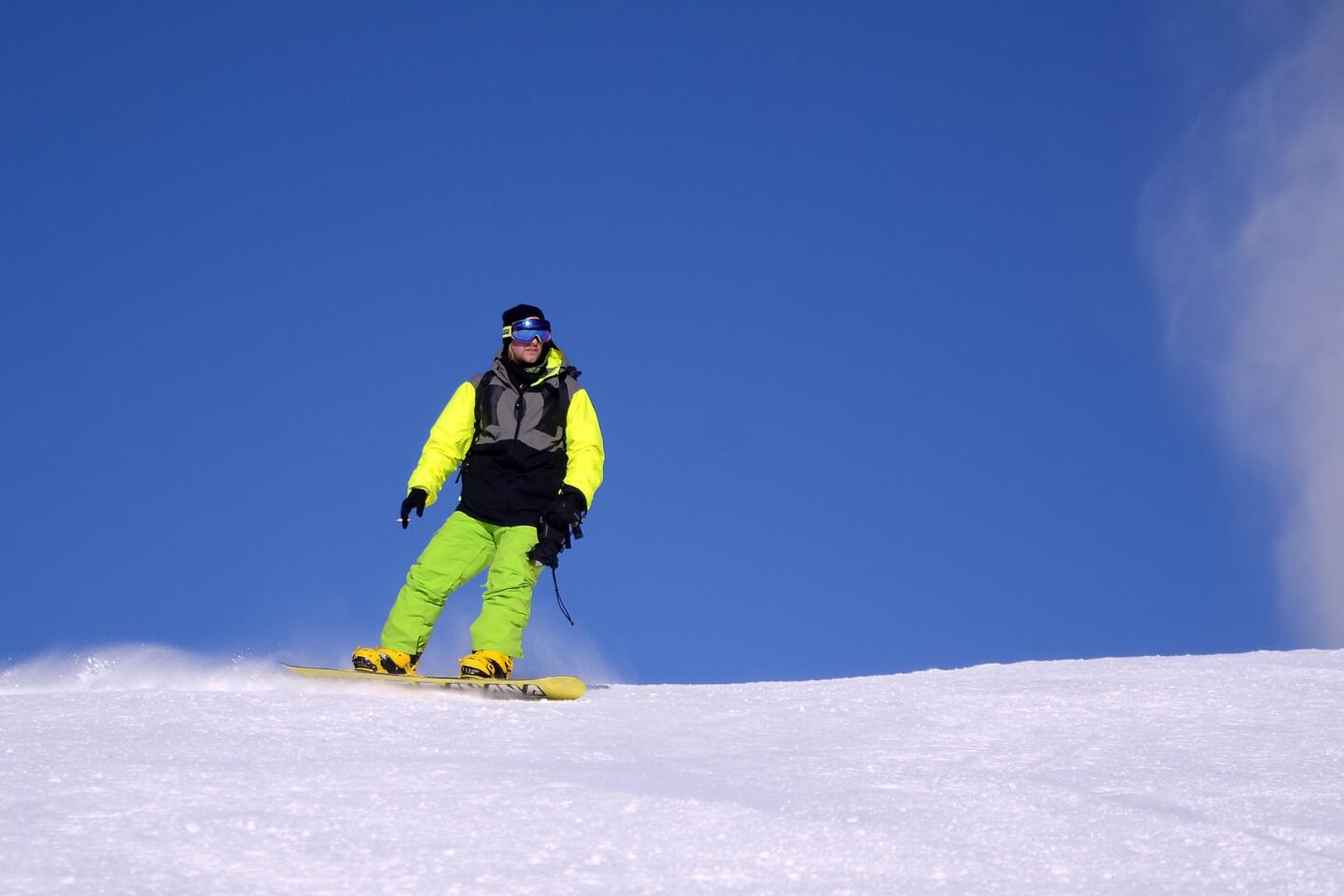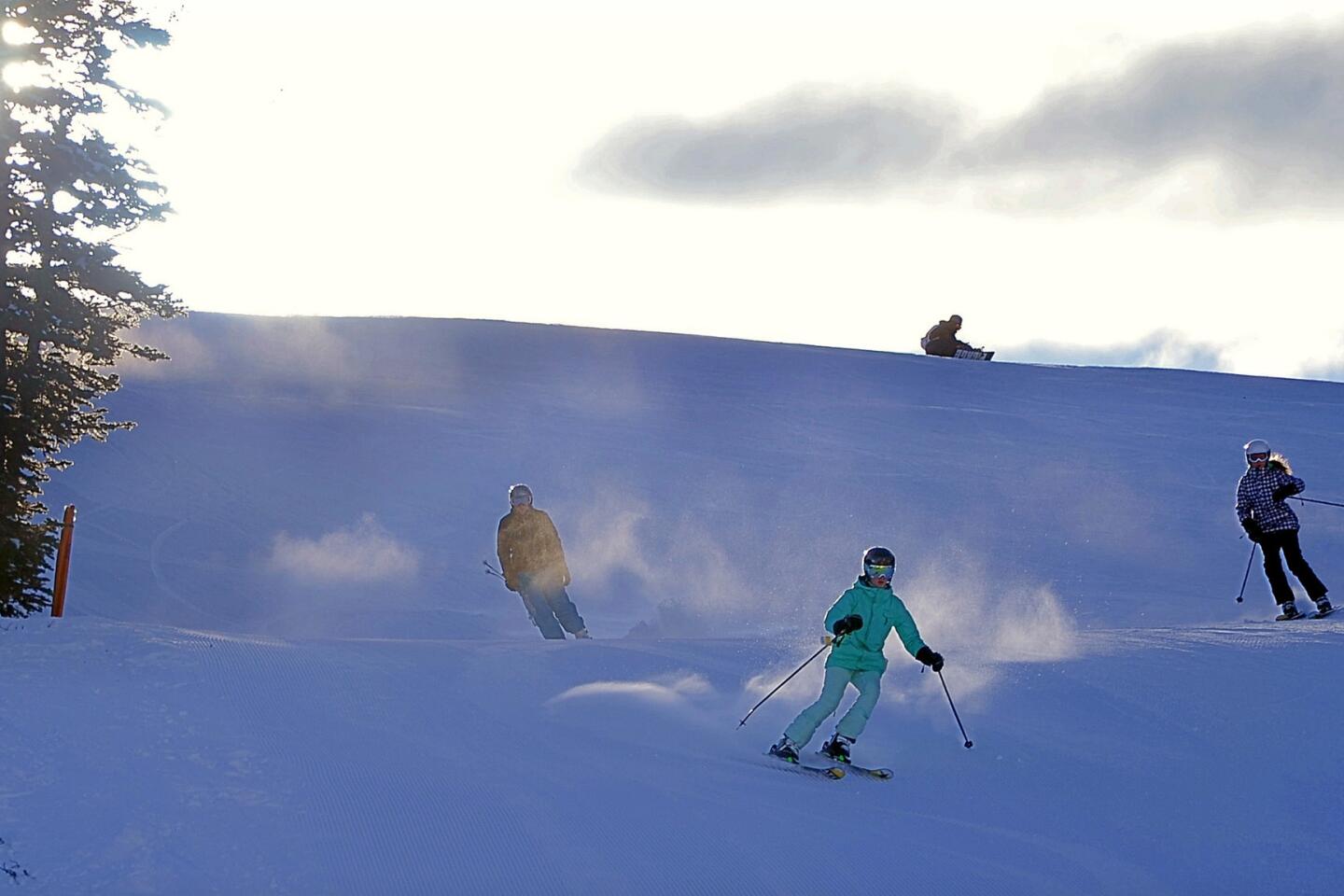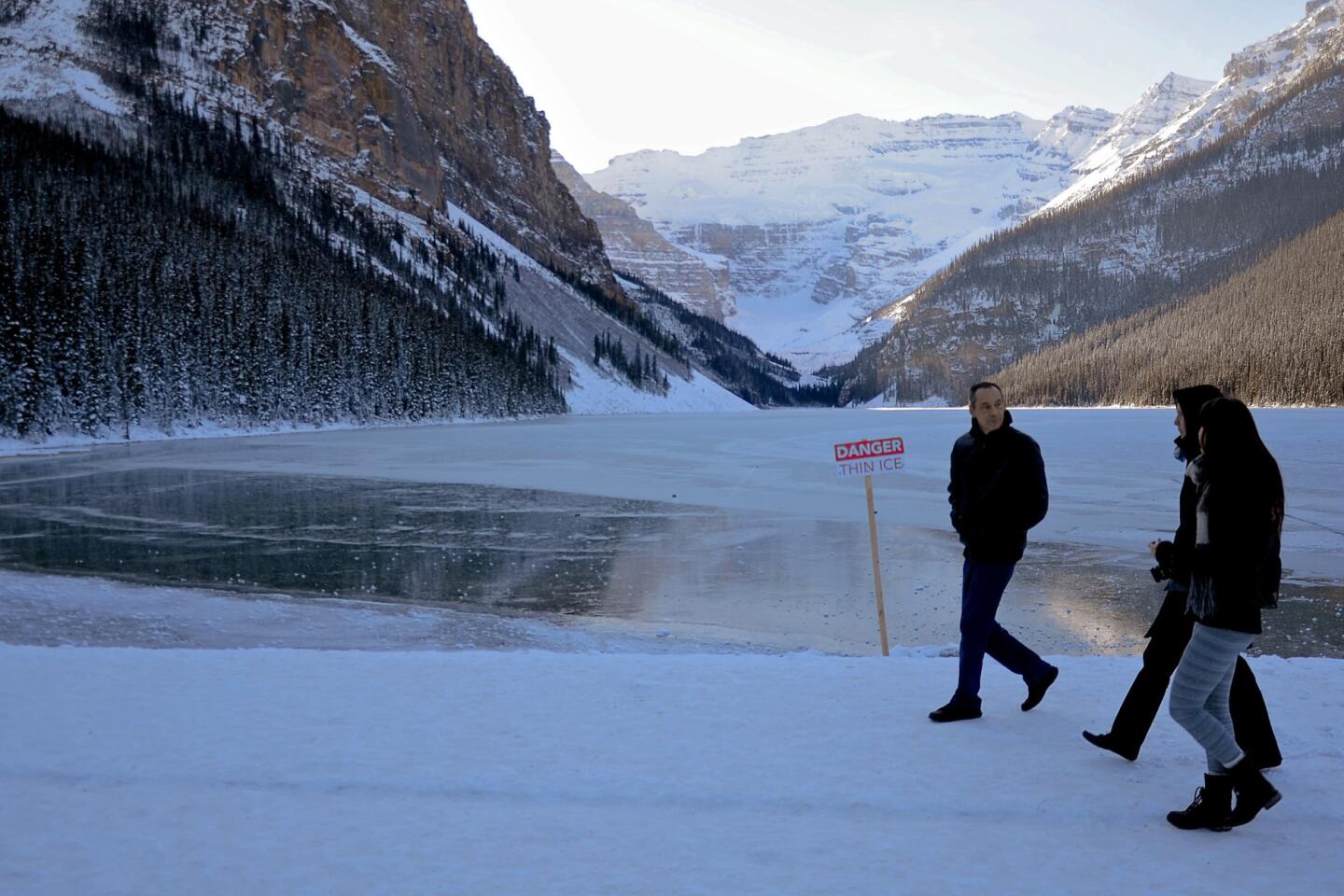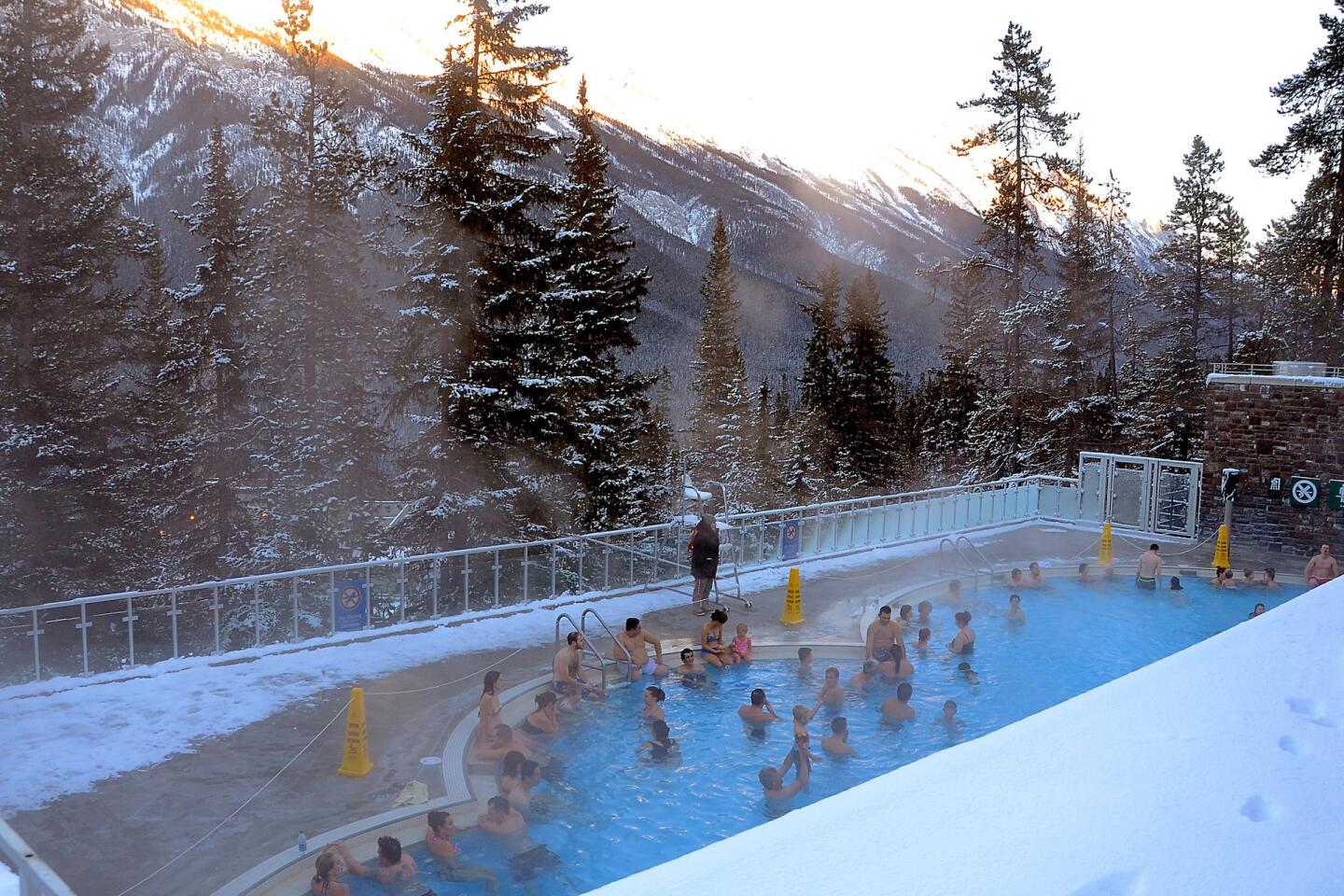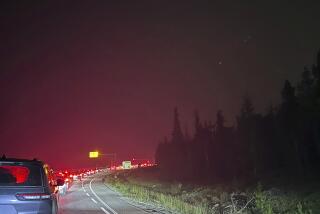Chilling on Alberta high country slopes
- Share via
Reporting from Banff, Canada — In Alberta’s high country, where the Trans-Canada Highway unfurls between Banff and Lake Louise, the Rockies march shoulder to shoulder flanking the road, peaks bristling, glaciers sparkling. The place looks so good in summer it’s practically a traffic hazard.
There are three ski resorts in the neighborhood — Sunshine Village, Lake Louise and Norquay — so you’d think a winter vacation here would be an easy sell. Apparently not.
It was not until the 1970s that Banff National Park’s two grand old railroad hotels — the Banff Springs Hotel and Chateau Lake Louise — began staying open through the winter months. Even now those three ski resorts, overshadowed by bigger Whistler Blackcomb in British Columbia, get only a smattering of skiers and boarders from outside the province.
Now, as snow falls and lifts lurch into action, let me speak up for Banff, Sunshine Village and Lake Louise. (I can’t speak for Norquay because it was still closed when I visited in mid-November.)
From California, the simplest approach is a flight to Calgary, then a 75-mile drive west on the straight and oft-plowed Trans-Canada Highway. That gets you to downtown Banff. From there it’s 10 more miles to Sunshine Village, 37 to Lake Louise.
As any summer visitor can attest, Banff (altitude, 4,537 feet; population, about 8,300) has more than its share of good restaurants and galleries, along with hot springs and staggering views of Cascade Mountain (9,836 feet), just north. As much as I like California’s Mammoth Mountain — especially the ease of access to its 5,000 skiable acres — the Banff area has more culture, more off-slope options, a more international feel.
The winter crowds on Banff Avenue are more manageable than the throngs of summer, and the après-ski scene is fueled partly by legions of Australian twentysomethings who come to work as “lifties” and play in the snow.
“I’m tired of Australians,” 24-year-old Sath Smith said with a sigh as we rode the gondola up to the slopes of Sunshine Village. He was kidding; he had arrived only recently from Brisbane. And he had already decided that Banff is “amazing.”
“I’ll just keep renewing my visa until I can’t anymore,” Smith said.
All around us, the horizon was crowded with jutting peaks, the lower slopes dense with flocked evergreens. Because the town and resorts fall within Banff National Park — Canada’s first, declared in 1885 — you don’t see time-share condos and vacation homes creeping along the riversides and ridgelines.
In fact, to build a 172-room hotel that’s due to open in 2016 at Banff Avenue and Moose Street, developers had to buy and raze three existing smaller hotels and two residences, as well as move a historic house. (That forlorn house sits now on an empty lot near the train station. Any day, I’m thinking, it may hop a freight for the coast.)
As for Sunshine Village, it isn’t a village as much as a slopeside hotel and a handful of restaurants and shops. But it’s gorgeous, and its dozen lifts feed 111 named runs on 3,358 skiable acres (20% beginner, 55% intermediate and 25% expert.) It feels doubly remote because the skiing doesn’t begin until you’ve made a long gondola ride up from the parking lot. The resort gets upward of 3,000 to 5,000 skiers and boarders on its busiest days.
I rode the only open chairlift (it was the second day of the season) and savored big views from several green (beginner) and blue (intermediate) runs. I also had a look at the Banff area’s only ski-in hotel, the eco-boutique Sunshine Mountain Lodge, a woodsy but contemporary lodging created by the 2012 redesign and expansion of the former Sunshine Village Inn.
The 88-room lodge sits atop a gondola route that closes most days around sunset, so it’s no place for a nightlife lover. But for a seeker of peace, quiet and easy chairlift access, it’s worth a look.
By Dec. 1, Sunshine Village had a 42-inch base of snow and 11 of its 12 lifts were open. The Old Farmer’s Almanac predicts Banff will see a colder, snowier winter than usual “with the snowiest periods in mid-December, mid- to late February, mid- to late March, and early April.”
My next mountain stop was the larger Lake Louise Ski Resort, which opened Nov. 13. It has more than 145 runs on 4,200 skiable acres. From the top of the Glacier Express chairlift, you can look a few miles across the valley and see a half-frozen lake under a huge glacier.
That’s Lake Louise, beloved for its turquoise tones in summer. In winter, it’s a frosty mirror, crisscrossed by skaters, neighbored by the Fairmont Chateau Lake Louise Hotel.
After a good squint at the lake, glacier and chateau, I took my turn careering down the slopes. Though the resort’s mix is 25% beginner, 45% intermediate and 30% expert, there’s a blue or green option from each of the five chairlifts. On its busiest days, the resort gets perhaps 7,000 skiers and boarders.
By Dec. 1, Lake Louise had a 38-inch base in its back bowls and eight of its 10 lifts were open.
I didn’t get to ride the Lake Louise Gondola (available to sightseers, skiers and boarders) because it wasn’t running yet. But after getting in some runs, I did stop by the lake, where the ice was still hardening and hikers were testing it by heaving rocks toward the middle. Every time one landed, a great thwack! — imagine Roger Federer launching a rocket serve in a handball court — would echo through the valley.
Another option for nonskiers, right in Banff, is the Banff Gondola, which climbs to a viewpoint high on Sulphur Mountain. Its base is just a few hundred yards from Banff Upper Springs, an outdoor pool whose 102-degree waters send endless steam into the winter sky. (Pressed for money? Do the springs, which costs about $6.50 per adult and skip the gondola, which costs about $32.)
If you have time, check out the Bow Falls viewpoint near the Banff Springs Hotel (the grander of the two old railroad hotels). Or drop by the Cave and Basin National Historic Site, and learn how the spot became the birthplace of the town and the Canadian park system after a railway employee found hot springs in the early 1880s.
But be sure to leave time for proper appreciation of Mt. Rundle, my favorite Canadian Rocky. It stands southeast of town, all serrated peaks and craggy charisma. From Vermilion Lakes on the outskirts of Banff, you get a clear view of it, with a line of dark trees in the foreground.
If you reach the lakes just ahead of dawn, as I did, it’ll probably be subfreezing. But as you walk the edge of these mostly frozen lakes and the darkness lifts, you’ll catch Mt. Rundle in the middle of an epic skyline view. You’ll catch it again upside-down, reflected in the unfrozen shallows, colored by the pink and orange sunrise.
By this time, if you’re taking pictures, you may be losing sensation in your fingers. But I can’t think of a nicer way to start a winter day.
If you go
THE BEST WAY TO BANFF, CANADA
From LAX, WestJet and Air Canada offer nonstop service to Calgary, and WestJet, Air Canada, United,US Airways and Delta offer connecting service (change of planes). Restricted round-trip fares from $479, including taxes and fees. From Calgary, it’s a 75-mile drive west to Banff.
ON THE SLOPES
For a Sunshine Village lift pass, adults pay $79 per day (www.skibanff.com). For a Lake Louise Ski Resort lift pass, adults pay $79 (www.skilouise.com). For a Mt. Norquay Ski Resort day pass, adults pay $58 per day (winter.banffnorquay.com).
For a pass that covers all three ski areas, the online, in-advance price is $87 per day, or $232 for three days (www.skibig3.com). The three resorts have also joined the Mountain Collective (mountaincollective.com), which offers a 14-day lift pass good at seven North American ski destinations for $399.
WHERE TO STAY
Delta Banff Royal Canadian Lodge, 459 Banff Ave., Banff; [800] 661-1379, bit.ly/1FkUN7N. Rooms for two typically $141-$221 in winter, more for suites. Delta is a Canadian brand with more than 40 locations.
Sunshine Mountain Lodge, 1 Sunshine Village Access Road, Banff; (877) 542-2633, sunshinemountainlodge.com. Rates typically $210-$310 (lift pass included) in winter, more for suites. Area’s only ski-in, ski-out hotel. It sits well up the mountain and is typically a quiet, nightlife-free zone.
Fairmont Banff Springs, 405 Spray Ave., Banff; (866) 540-4406, www.fairmont.com/banff-springs. Palatial buildings, prime riverside view location, 768 rooms, several restaurants, indoor and outdoor pools, spa. Rooms for two typically $320-$535 in winter, more for suites. Some rooms tiny.
Banff Y Mountain Lodge (which becomes the YWCA Banff Hotel on Jan. 1), 102 Spray Ave., Banff; (866) 332-3560, www.ymountainlodge.com. For budget travelers. Free Wi-Fi, continental breakfast included. Five-minute walk to downtown nightlife. Rooms for two with private baths typically $55 in winter; with shared baths, about $50 per night. Dorm beds start at about $28 a night in winter. Operates as a nonprofit aimed at promoting affordable housing and reducing family violence.
WHERE TO EAT
Block Kitchen & Bar, 201 Banff Ave., Suite 5 (facing Caribou Street) Banff; (403) 985-2887, banffblock.com. A tiny dining room just off the main drag. Sophisticated “Mediterrasian” fare. Opened in 2014. Lunch, dinners and many small plates, mostly $7-20.
Bison Restaurant & Terrace, 213, 211 Bear St., Banff; (403) 762-5550, www.thebison.ca. Excellent steak with lots of regional sourcing in a dim, date-night setting. Main dishes $17-$42. Dinner daily, brunch on Sundays.
Nourish Bistro, 211 Bear St., Suite 110; Banff; (403) 760-3933, nourishbistro.com. In cattle-ranching Alberta, this mostly vegan menu stands out. Lunch and dinner. Dinner main dishes about $12-$23.
TO LEARN MORE
Banff & Lake Louise Tourism, www.banfflakelouise.com; Banff National Park, bit.ly/SUo4ED; Alberta Tourism, travelalberta.us.
christopher.reynolds@latimes.com
Twitter: @mrcsreynolds
More to Read
Sign up for The Wild
We’ll help you find the best places to hike, bike and run, as well as the perfect silent spots for meditation and yoga.
You may occasionally receive promotional content from the Los Angeles Times.

